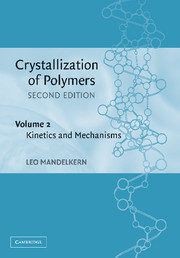9 - Crystallization kinetics of homopolymers: bulk crystallization
Published online by Cambridge University Press: 15 December 2009
Summary
Introduction
In discussing the crystalline state of polymers the concern up to now has been primarily with equilibrium concepts and expectations. Although the fusion of polymers is well established to be a problem in phase equilibrium, stringent experimental procedures must be employed to approach the necessary conditions. It is concluded from equilibrium theory that for homopolymers of regular structure high levels of crystallinity should be attained. However, this conclusion is contrary to usual experience. Since the crystalline phase only develops at a reasonable rate at temperatures well below the equilibrium melting temperature, the state that is actually observed in a real system is a nonequilibrium one. The constitution and properties of the state that is achieved are the result of the competition between the kinetic factors involved in the transformation and the requirements for thermodynamic equilibrium. In a formal sense one is dealing with a metastable state. This generalization is not unique to polymer crystallization. It also holds for a vast majority of substances that undergo a liquid to crystal transformation. For polymers, however, kinetic control is the dominant factor. For example, the crystallization from the melt of an n-alkane of about one hundred carbon atoms occurs extremely rapidly at a temperature just infinitessimally below its equilibrium melting temperature.
- Type
- Chapter
- Information
- Crystallization of Polymers , pp. 1 - 214Publisher: Cambridge University PressPrint publication year: 2004
- 2
- Cited by



